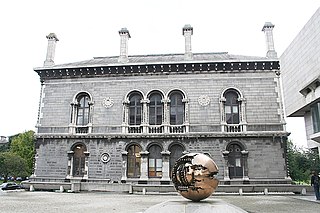
The National Museum of Ireland is Ireland's leading museum institution, with a strong emphasis on national and some international archaeology, Irish history, Irish art, culture, and natural history. It has three branches in Dublin, the archaeology and natural history museums adjacent on Kildare Street and Merrion Square, and a newer Decorative Arts and History branch at the former Collins Barracks, and the Country Life museum in County Mayo.

William Conyngham Plunket, 4th Baron Plunket was Dean of Christ Church Cathedral and Archbishop of Dublin in the Church of Ireland.

Molesworth Street is a street in Dublin, Ireland named after Richard Molesworth, 3rd Viscount Molesworth and links the more notable Dawson Street with Kildare Street and lies just over 200 m to the north of St. Stephens Green in Dublin's central business district.

Benjamin Woodward was an Irish architect who, in partnership with Sir Thomas Newenham Deane, designed a number of buildings in Dublin, Cork and Oxford.

Sir Thomas Deane was an Irish architect. He was the father of Sir Thomas Newenham Deane, and grandfather of Sir Thomas Manly Deane, who were also architects.
Sir Thomas Manly Deane was an Irish architect, the son of Sir Thomas Newenham Deane and grandson of Sir Thomas Deane, who were also architects.

O'Shea and Whelan was an Irish family practice of stonemasons and sculptors from Ballyhooly in County Cork. They were notable for their involvement in Ruskinian gothic architecture in the mid-19th century.
William Atkins (c.1811–1887) was an Irish architect of the Victorian era. He was born in County Cork, and was reputedly apprenticed to architect George Richard Pain.
Blackrock is a suburb, with a village core, in the south east of Cork City, Ireland. Originally a small fishing village about five kilometres from Cork City, the growth of the city over time has meant that the village has become incorporated into the city. It is home to Blackrock GAA club, Blackrock Castle, a weekly farmers market, and as of 2015 has seen some investment in regeneration projects for the traditional village centre. Blackrock is within the Cork South-Central Dáil constituency.

Charles Graves was an Irish mathematician, academic, and clergyman. He was Erasmus Smith's Professor of Mathematics at Trinity College Dublin (1843–1862), and was president of the Royal Irish Academy (1861–1866). He served as dean of the Chapel Royal at Dublin Castle, and later as Bishop of Limerick, Ardfert and Aghadoe. He was the brother of both the jurist and mathematician John Graves, and the writer and clergyman Robert Perceval Graves.
John Parker was a Church of Ireland clergyman who came to prominence after the English Restoration, first as Bishop of Elphin, then as Archbishop of Tuam and finally as Archbishop of Dublin and Primate of Ireland.

St. Peter's Church was a former Church of Ireland parish church located in Aungier Street in Dublin, Ireland, where the Dublin YMCA building now stands. It was built on land that formerly belonged to the Whitefriars in Dublin. It served the largest Church of Ireland parish in Dublin.
William Alphonsus Scott (1871–1921) was an Irish Roman Catholic ecclesiastical architectural historian, academic, and architect active throughout late—nineteenth-century and early twentieth-century Ireland. His offices were first located in Drogheda, later located at 45 Mountjoy Square, Dublin.
Jemmett Browne was the Church of Ireland Bishop of Killaloe from 1743 to 1745, Bishop of Dromore for three months in the middle of 1745, Bishop of Cork and Ross from 1745 to 1772, Bishop of Elphin from 1772 to 1775, and finally Archbishop of Tuam from 1775 until his death in 1782.

The Kildare Street Club is a historical member's club in Dublin, Ireland, at the heart of the Anglo-Irish Protestant Ascendancy.
Sir James Creed Meredith was Deputy Grand Master and Treasurer of the Grand Lodge of Ireland; Chancellor of the Diocese of Limerick; Secretary to the Royal University of Ireland and the National University of Ireland. A prominent Freemason, J. Creed Meredith Masonic Lodge at Belfast was named in his honour. He is not to be confused with his son, Judge James Creed Meredith.

The Museum Building is a building within Trinity College. Finished in 1857 and located on the south of New Square, it is home to the University's Geology, Geography, Mechanical Engineering and Civil Engineering departments. It is a Palazzo style building, inspired by Byzantine architecture of Venice, and finished in Lombardo−Romanesque detailing, with over highly decorated 108 carved capitals.
John Joseph O'Callaghan was an Irish architect who designed buildings in both England and Ireland.
Deane is a surname and given name. People with the name include:

James Edward Rogers was an Irish artist, architect, and book-illustrator whose early career was in Dublin. In 1876 he moved to London, where he is believed to have worked only as an artist.












